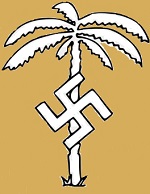Corgi CC60013 German Krauss-Maffei Sd. Kfz. 7/1 8-Ton Semi-Tracked Personnel Carrier/Prime Mover - Unidentified Unit, Deutsches Afrika Korps, Tunisia, May 1943 (1:50 Scale)
"The peril of the hour moved the British to tremendous exertions, just as always in a moment of extreme danger things can be done which had previously been thought impossible. Mortal danger is an effective antidote for fixed ideas."
- Generalfeldmarschal Erwin Rommel
 Development of the Sd. Kfz. 7 can be traced back to a 1934 requirement for an 8-ton half-track. The vehicle first appeared in 1938 and was destined to be used mainly as the tractor for the 8.8cm flak gun. The Sd. Kfz. 7 was an extremely useful vehicle, employed both as a weapons carrier and prime mover by the Wehrmacht. They also saw service as observation and command posts for V2 rocket batteries. The vehicle could carry up to 12 men and a considerable quantity of supplies, as well as pulling up to 8000kg (17,600 lbs) of equipment. Most were fitted with a winch, which enabled them to pull smaller disabled vehicles out of mud or other quagmires. A mainstay of the German Army, the Sd. Kfz. 7 was even admired by the enemies of the Reich. In fact, the British tried to make exact copies of captured Sd. Kfz. 7s and some vehicles were appropriated for use by the Allies after World War II.
Development of the Sd. Kfz. 7 can be traced back to a 1934 requirement for an 8-ton half-track. The vehicle first appeared in 1938 and was destined to be used mainly as the tractor for the 8.8cm flak gun. The Sd. Kfz. 7 was an extremely useful vehicle, employed both as a weapons carrier and prime mover by the Wehrmacht. They also saw service as observation and command posts for V2 rocket batteries. The vehicle could carry up to 12 men and a considerable quantity of supplies, as well as pulling up to 8000kg (17,600 lbs) of equipment. Most were fitted with a winch, which enabled them to pull smaller disabled vehicles out of mud or other quagmires. A mainstay of the German Army, the Sd. Kfz. 7 was even admired by the enemies of the Reich. In fact, the British tried to make exact copies of captured Sd. Kfz. 7s and some vehicles were appropriated for use by the Allies after World War II.
Pictured here is a 1:50 scale replica of a German Krauss-Maffei Sd. Kfz. 7/1 8-ton semi-tracked personnel carrier/prime mover that was attached to an unidentified unit then deployed to Tunisia during May 1943.
Now in stock!
Dimensions:
Length: 5-inches
Width: 2-inches
Release Date: January 2020
Historical Account: "Death of an Elite" - By mid-November 1942, the Allies were able to advance into Tunisia but only in single division strength. By early December, the Eastern Task Force -- which had been re-designated as the British First Army under Lieutenant-General Kenneth Anderson -- was composed of the British 78th Infantry Division, British 6th Armoured Division, 1st Parachute Brigade, No. 6 Commando and elements of US 1st Armored Division. But by this time, one German and five Italian divisions had been shipped from Europe and the remoteness of Allied airfields from the front line gave the Axis clear air superiority over the battlefield. The Allies were halted and pushed back having advanced eastwards to within 30 kilometres (19 mi) of Tunis.
During the winter, there followed a period of stalemate during which time both sides continued to build up their forces. By the new year, the British First Army had one British, one US and one French Corps (a second British Corps headquarters was activated in April). In the second half of February, in eastern Tunisia, Rommel and von Arnim had some successes against the mainly inexperienced French and US troops, most notably in routing the US II Corps commanded by Major General Lloyd Fredendall at the Battle of Kasserine Pass.
By the beginning of March, the British Eighth Army -- advancing westward along the North African coast -- had reached the Tunisian border. Rommel and von Arnim found themselves in an Allied "two army" pincer. They were outflanked, outmanned and outgunned. Rommel went back to Germany for health reason and was substituted by the Italian general Messe.
The British Eighth Army bypassed the Axis defense on the Mareth Line in late March after harsh fighting and First Army in central Tunisia launched their main offensive in mid-April to squeeze the Axis forces until their resistance in Africa collapsed. The Axis forces surrendered on May 13th, 1943 yielding over 275,000 prisoners of war. The last Axis force to surrender in North Africa was the 1st Italian Army of general Messe. This huge loss of experienced troops greatly reduced the military capacity of the Axis powers, although the largest percentage of Axis troops escaped Tunisia. This defeat in Africa led to all Italian colonies in Africa being captured.


